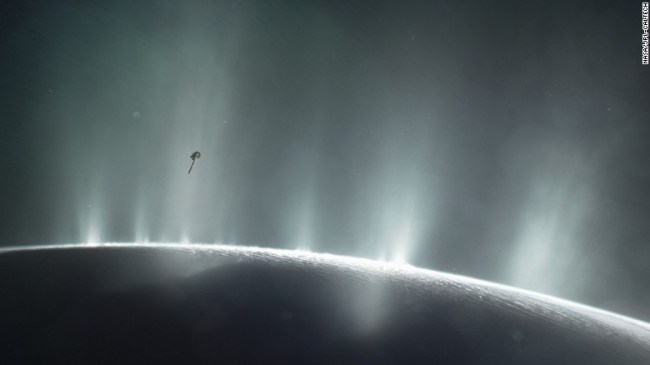NASA discovered evidence that two neighboring ocean worlds in our solar system just might have the right mix to sustain extraterrestrial life. Researchers believe that the icy, ocean-bearing moons of Jupiter and Saturn could host life.
Thanks to NASA’s Cassini mission and the Hubble Space Telescope, NASA was able to determine that Jupiter’s moon Europa and Saturn’s moon Enceladus have the right conditions for alien life.
“This is the closest we’ve come, so far, to identifying a place with some of the ingredients needed for a habitable environment,” said Thomas Zurbuchen, associate administrator for NASA’s Science Mission Directorate at Headquarters in Washington. ”These results demonstrate the interconnected nature of NASA’s science missions that are getting us closer to answering whether we are indeed alone or not.”
The Cassini spacecraft detected hydrogen gas in a plume of gas and icy material spraying from Enceladus during its last, and deepest, dive through the plume on Oct. 28, 2015. Hydrogen gas is pouring into the subsurface ocean of Enceladus from hydrothermal activity on the seafloor then bursting through the moon’s icy crust. This chemical reaction could potentially provide a chemical energy source for life on the ice-covered world that is Saturn’s sixth-largest moon.
Cassini grabbed a sample of plume and scientist determined that nearly 98 percent of the plume is water, about 1 percent is hydrogen, and the rest is a mixture of other molecules including carbon dioxide, methane, and ammonia.
From NASA:
The presence of ample hydrogen in the moon’s ocean means that microbes – if any exist there – could use it to obtain energy by combining the hydrogen with carbon dioxide dissolved in the water. This chemical reaction, known as “methanogenesis” because it produces methane as a byproduct, is at the root of the tree of life on Earth, and could even have been critical to the origin of life on our planet.
Life as we know it requires three primary ingredients: liquid water; a source of energy for metabolism; and the right chemical ingredients, primarily carbon, hydrogen, nitrogen, oxygen, phosphorus and sulfur. With this finding, Cassini has shown that Enceladus – a small, icy moon a billion miles farther from the sun than Earth – has nearly all of these ingredients for habitability. Cassini has not yet shown phosphorus and sulfur are present in the ocean, but scientists suspect them to be, since the rocky core of Enceladus is thought to be chemically similar to meteorites that contain the two elements.
Hubble’s Space Telescope Imaging Spectrograph (STIS) found similar spouting plumes on Jupiter’s moon Europa in ultraviolet light at the same location in 2014 and 2016. Europa’s recent plume rises approximately 62 miles above the surface, while the one captured in 2014 was estimated to be 30 miles high.
Scientists are still in the process of monitoring Europa to determine the frequency with which the plumes appear.
However, don’t expect the alien life to be E.T. or a Xenomorph. If there is life on the moons it would likely be microbes. Scientists equate the possible extraterrestrial life to that of microbes that live in the hot cracks on the ocean floors. Eventhough there is no sunlight on Earth’s ocean floor, the microbial life survices from chemical reactions.
From NDTV:
Microbes would be able to use the process of methanogenesis, in which hydrogen is combined with carbon dioxide dissolved in the water, to obtain energy. This process creates methane as a byproduct; methane is found in abundance on the Earth.
Hunter Waite, lead author of the Cassini study, said, “Although we can’t detect life, we’ve found that there’s a food source there for it. It would be like a candy store for microbes.”


